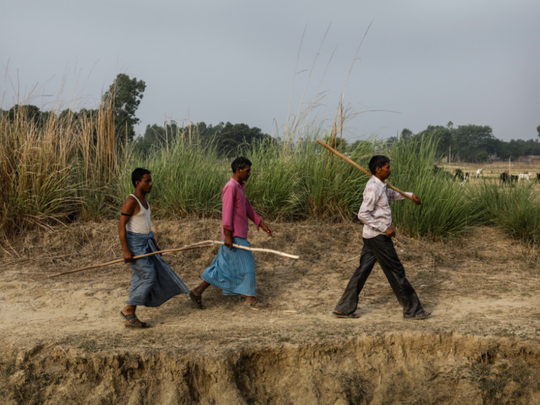
KHAIRABAD, Uttar Pradesh: On an evening just a few minutes before the sun went down, Sahreen Bano, a 10-year-old girl, walked into a sugar cane field to relieve herself before going to bed. A pack of wild dogs was waiting for her.
The dogs formed a tight ring and then closed in, pulling her down as one dog’s teeth sank into her neck. She screamed. Nearby farmers dashed in as fast as they could, rocks, sticks and hoes in their hands, yelling at the top of their lungs.
But the attack on Sahreen was not an isolated event. At least 14 children have been mauled to death by dog packs around Khairabad in recent months.
Khairabad is a little town, off a highway in northern India, with houses that are small and smothered in dust; most of the villagers are farmers and on this terrifying dog menace, they blame politicians for their lack of initiative in tackling the problem.
- Dr R.K. Singh | Director, Indian Veterinary Institute
The root of the stray dogs problem could well be traced to the decision of the Uttar Pradesh government to shut down most of the state’s slaughterhouses, in fact scores of them.
The stated reason was that many were operating illegally. But residents are not convinced.
Khairabad, like just about any other Indian village, has a lot of strays. Many of the strays used to survive off scraps from the slaughterhouse, and after it was abruptly shut down, villagers and veterinarians said, some of the strays might have gone mad with hunger.
“Because these dogs are getting less food, they move towards the neighbourhoods in search of food,” said Dr. R.K. Singh, director of the Indian Veterinary Research Institute. “That is leading to intense human-animal interaction.” Children, he said, were “a soft target.”
And nothing — not increased police patrols, high-level visits, a surveillance drone or a dog vigilante squad that employs macabre tactics — has been able to stop the attacks.
On a recent Wednesday afternoon, minutes after another young girl was mauled in a mango orchard, a squad of police officers, wearing jeans and gym shoes, rushed to the area.
They sprinted past the arcing mango trees heavy with hard, green fruit and into the endless sugar cane fields. They were sweating through their shirts, yelling to each other to go this way or that, rifles and shotguns bouncing on their backs.
But the officers didn’t squeeze off a single shot. The killer dogs had vanished.
Not normal strays
School attendance is dropping. Khairabad’s farmers are terrified to linger in their fields, especially at night. Recently, wild dogs struck again, attacking five people.
But the government is prickly when asked about Khairabad’s dog menace, denying that the closure of the slaughterhouses had anything to do with it. “Why would the dogs of only Khairabad turn into man eaters when slaughterhouses have been shut down all over?” said Awadhesh Kumar Yadav, an urban development officer.
That remains a mystery, though veterinarians said dog attacks were happening in other areas as well.
The forensics here in Khairabad tell their own story. Pictures of mauled children reveal that the dogs clamped down on their throats, the way a leopard or a lion takes down its prey.
A few adults were attacked as well, but none killed.
The dogs, who may come from one pack, had developed a taste for human flesh. On some days, maulings are reported eight to 16km apart, in the span of just a few hours, a lot of ground for a dog to cover.
But these are not normal strays, villagers insist. They can run 64km/h, “faster than a motorbike,” said Ayub Khan, a village elder. Their mouths were larger, their health better, and, he added with wide eyes and a knowing nod, “their jump is very long.”
Police officers say the dogs travel in packs of five to seven; according to tests performed on several animals linked to the attacks, none were rabid. More than 40 suspicious strays have been captured and sterilised, but that has not made any difference.
The dog vigilantes are not taking any chances. On a recent evening, they moved out en masse, dozens of men and a few preteen boys, all carrying sticks, knives or axes.
They spread out across the sugar cane fields and mango orchards, just about the only source of jobs out here. As they moved, the village dogs lounging in the shadows seemed to sense trouble and scrambled up and hightailed it away.
The vigilantes were clear that they were not trying to kill the dogs; India’s dog laws are quite protective and courts have ruled it is illegal to cull strays.
Not far from where the vigilantes were mustered stood the Khairabad slaughterhouse. It’s now deserted, the sun casting harsh shadows on its empty courtyard. All the dogs who used to hang around have disappeared.
Many villagers here said they never suffered such vicious dog attacks when the slaughterhouse was open.
— New York Times News Service












